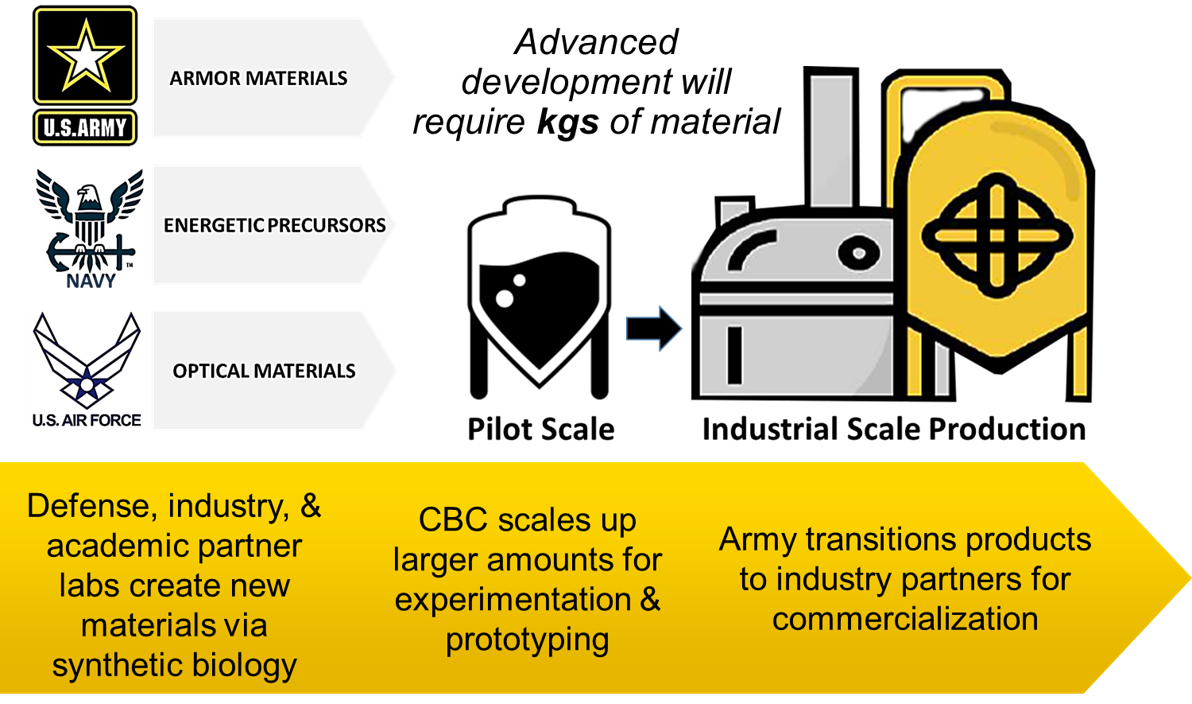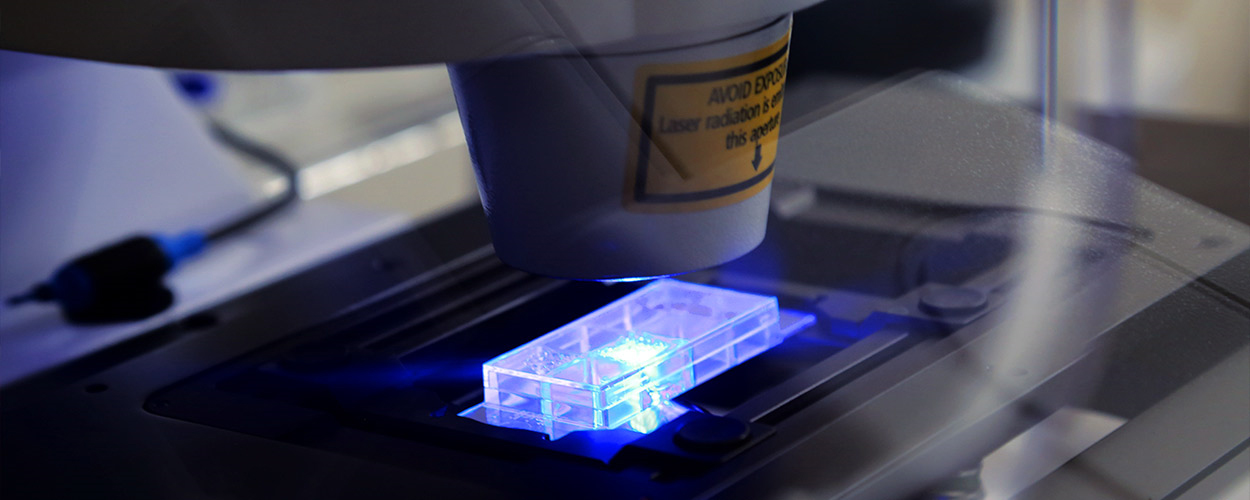Synthetic Biology Grand Challenge Concludes
Synthetic Biology Grand Challenge Concludes
Investment positions center to become biomanufacturing leader
By Jerilyn Coleman
Scientists at the U.S. Army Combat Capabilities Development Command Chemical Biological Center (DEVCOM CBC) concluded the 2017-20 Grand Challenge known as Biological Engineering for Advanced Materials Solutions (BEAMS) on June 25. As personnel across the Center gathered via Microsoft Teams, Center chemist and principal investigator on the Grand Challenge, Jared DeCoste, Ph.D., provided an overview of the challenge, what they’ve accomplished, lessons learned and things to look forward to in the future.
The Investment
Scientists at the Center utilized synthetic biology to harness naturally occurring biological processes to create novel and advanced materials within the BEAMS program. The goal of BEAMS was to lay the foundations to establish the Center as the DoD leader in the area of synthetic biology for materials. In 2017, they set out to do this by educating the workforce, creating an infrastructure for synthetic biology and creating a synthetic biology portfolio. In the last three years, the Center has invested $1.8 million into this Grand Challenge. “I can’t say enough how much the Center rallied around this Grand Challenge, and how many people have been involved from day one,” DeCoste said. During this Grand Challenge, the Center has developed new equipment, research and partnerships that put them at the forefront of synthetic biological solutions.
A Winning Team
Just like the Grand Challenge before it, and the one to follow, the key to the success of BEAMS was solid collaboration between the brightest scientists and engineers at the Center. DeCoste searched throughout the Center for enthusiastic individuals with diverse backgrounds who were already involved in synthetic biology efforts, and people who specialize in different areas that would be beneficial to highlighting the Center. In addition to DeCoste, the core team consisted of research biologists Matthew Lux and Daniel Angelini; post-doctoral fellow Mary Lee and chemical engineer Sabrina Rawlings Seiple. “No one aspect, group, branch or division could solve this Grand Challenge by themselves, so we had to invest in minds across the Center,” DeCoste said. Additionally, the core team collaborated with external researchers at the Massachusetts Institute of Technology (MIT) and a variety of other institutions including the Air Force Research Laboratory, Naval Research Laboratory, Navy Warfare Center, Northwestern University and more. DeCoste and the core team stressed the importance for experts from various disciplines to work together, communicate, collaborate and speak the same synthetic biology language.
Accomplishments
Over the past three years, the core team worked on several innovations. Perhaps one of the most immediate needs during the challenge was to develop human capital and educate personnel at the Center about the subject matter. The core team started by leading a lecture series that received attendance from about 100 unique individuals, and a total attendance of about 500 across the lectures collectively. “People were excited to be engaged in a new way,” DeCoste said.
While the lecture series was helpful and encouraged more conversations about synthetic biology within the Center, scientists and engineers wanted hands-on projects. This created a great segue to the BEAMS Laboratory Competition. Twenty-three people across the Center were organized into five teams. The teams were tasked to develop the strongest nanocellulose, a polymer that is produced by bacteria. Some teams used 3D printer molds, various nutrients and other methods to increase the strength of the nanocellulose.
The synthetic biology projects helped the BEAMS core team recognize what equipment was needed to benefit the Center in the area of synthetic biology and they decided to invest in a confocal laser focused microscope, which is now installed in the BioChemistry area of the Berger Building.
Once the core team acquired educational resources and the equipment they needed, they established research projects to carry out the challenge. The core team focused on four areas, with biomanufacturing being the first. Biomanufacturing uses living systems to produce a molecule that may not easily be synthesized using traditional chemistry. The biomanufacturing focus birthed Protoporphyrin IX, which can absorb light and modify oxygen to create the highly reactive singlet oxygen, that can decontaminate a mustard agent and degrade it to a less harmful product.
The team also worked to mobilize cell-free lysates to take an organism like E. Coli, remove the biological machinery and place it into a solution. Additionally, BEAMS participated in MIT’s Defense Advanced Research Projects Agency 1000 Molecules program. The Center has been working with MIT to design carbons with high surface areas and the functionality to react with toxic chemicals for incorporation into gas mask filters and textiles. “BEAMS was able to supplement the program to de-risk emerging technologies out of this program, including the initial scaling of material,” DeCoste said.
Moving Forward
In the future, the core team plans to continue to advance their goals. When BEAMS was established as the Grand Challenge investment for 2017, Center leaders intended for it to be a long-term effort past the designated three years. Going forward, BEAMS and synthetic biology will be a big part of the Center’s chemical biological defense strategy. “BEAMS was able to establish the Center as a key contributor to the DoD biotechnology ecosystem,” DeCoste said.
The core team’s research in cell-free lysates has earned an upcoming $5 million Congressional investment with Northwestern University, the expert in cell-free manufacturing. A brand-new biomanufacturing facility is being established, more manuscripts will be published, and experts will continue to speak about synthetic biology at conferences and in other venues to ensure that the Center is always part of the conversation.
The core team will also prioritize how the Center responds to crises and they believe they have positioned themselves to do this well in the last three years. The team is beginning to think about how to utilize synthetic biology in the development of materials and detection. “Synthetic biology is a tool. Across our Center we have a lot of goals and synthetic biology doesn’t always have to be the answer, but it should be something that we have in the back of our minds as a potential way to solve our problems,” said DeCoste.
DeCoste asserted that one of the biggest lessons he’s learned during this Grand Challenge is to be flexible. “BEAMS allowed us to leverage internal funding to bridge gaps. We turned unfunded work into funded work.” He hopes the next Grand Challenge team can take that from their experience. He challenges them to fund ideas out of the Grand Challenge that are small seedling efforts that could grow into powerful tools.

The confocal laser focused microscope was an investment through the BEAMS Grand Challenge. It now sits in the BioChemistry area of the Berger Building. Photo by DEVCOM CBC Public Affairs Office.

